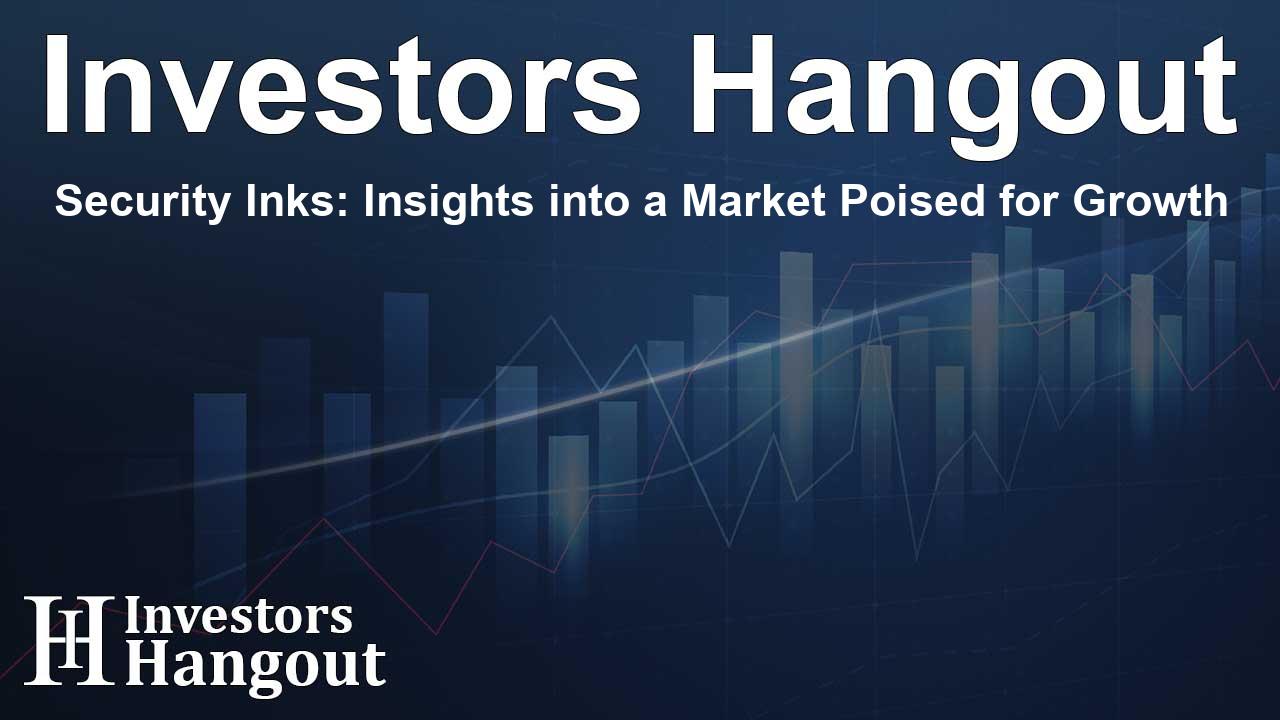Security Inks: Insights into a Market Poised for Growth

Overview of the Security Inks Market
The security inks market is on a remarkable growth trajectory, expected to reach USD 4.94 billion by 2032, up from USD 3.41 billion in 2023. This represents a compound annual growth rate (CAGR) of 4.20% from 2024 to 2032. The surge in demand for advanced security inks is closely linked to increasing concerns about counterfeiting and enhanced regulatory measures across various industries.
Market Drivers: The Push for Anti-Counterfeiting Solutions
As industries work diligently to thwart counterfeiting and forgery, the demand for security inks has skyrocketed. Recent statistics highlight a 20% increase in counterfeit currency detection within just three years. This alarming trend has further emphasized the necessity for secure printing technologies, particularly in the banking sector. For instance, the European Central Bank's removal of 376,000 counterfeit euro banknotes highlights the crucial need for robust security measures. Moreover, the urgency imposed by counterfeit drugs in the pharmaceutical industry necessitates stringent adherence to FDA regulations, driving a shift toward advanced secure printing solutions.
Growth in Different Sectors
Luxury brands have also begun incorporating security labels to mitigate product imitations. The integration of digital security printing, along with innovations in biometric security inks, especially for government-issued IDs, is contributing to the market's expansion. Notable companies, including SICPA and Sun Chemical, are at the forefront, intensifying research and development efforts to create resilient and anti-tampering ink formulations.
The United States Security Inks Market
In the U.S. alone, the security inks market has been valued at USD 0.52 billion in 2023, with projections to reach USD 0.76 billion by 2032. This growth is fueled by stringent anti-counterfeiting regulations and a shift toward sophisticated authentication methods in financial transactions and vital documents. Reportedly, counterfeit incidents have risen, prompting the Federal Reserve to enhance the security features of U.S. currency. Additionally, pharmaceutical companies are adopting security labels on drug packages to align with the Drug Supply Chain Security Act.
Key Players and Innovations in the Security Inks Market
The competition in the security inks industry is fierce, with key players making strides in innovation and technology. Companies like Chromatic Technologies Inc. and DIC Corporation (Sun Chemical) are leading the charge with products such as Color-Shift and UV inks tailored for security applications. These innovations are aimed at elevating security across various sectors, from packaging to banknotes.
Innovations Transforming Security Inks
Technological advancements have given rise to inks that react to unique biometrics and incorporate nanoparticles for enhanced security features. Furthermore, there are developments in color-changing inks triggered by temperature fluctuations and RFID-integrated inks for superior tracking and authentication purposes. Additionally, visible inks under ultraviolet light are gaining traction, especially in applications targeted at counterfeiting prevention.
Market Segmentation and Trends
The security inks market can be categorized in several ways, with invisible inks leading the charge, holding a significant 35.4% market share in 2023. These inks play a crucial role in high-security applications such as banknotes, government documents, and anti-counterfeit labels. Their discreet nature allows them to remain undetected under regular lighting conditions while revealing distinct identifiers under ultraviolet light. Notably, the Federal Reserve has enhanced currency security by integrating UV-reactive inks into newly printed dollar bills.
Dominance of Intaglio Printing Method
The intaglio printing segment commands a dominant 39.5% market share due to its extensive use in currency and high-security documents. The process involves creating raised impressions that are difficult to reproduce with standard printing techniques, making it a favored method among central banks for producing banknotes suitable for resisting counterfeiting.
Applications of Security Inks
Security labels represent the most significant application segment, constituting approximately 36.2% of the market. These labels are essential across industries for brand protection and ensuring product safety in pharmaceuticals. To combat the growing threat of counterfeit consumer goods and fulfill supply chain security needs, companies are investing in high-security label solutions with tamper-evident features and advanced holographic inks.
Regional Analysis and Opportunities
The Asia Pacific region has emerged as a powerhouse in the security inks market, commanding a remarkable 40.4% share. Government initiatives in countries like China, India, and Japan are pivotal in combating counterfeiting. These nations are witnessing the implementation of stringent regulations, prompting increased adoption of security inks in banknotes and official documentation.
North America's Rapid Growth
North America boasts the fastest growth rate in the security inks market, supported by robust anti-counterfeiting policies and substantial investments in security technologies. The region is seeing an uptick in the use of security inks across banknotes, legal documentation, and pharmaceutical packaging. The U.S. government's strategic funding aims to enhance security features in federal documentation, driving demand for innovative solutions.
Recent Developments in the Industry
A key development includes IN Groupe's acquisition of Gleitsmann Security Inks, which bolsters its capabilities in secure printing. This strategic move is part of a broader mission to enhance protection against counterfeiting threats while extending their secure product offerings.
Frequently Asked Questions
What drives the growth of the security inks market?
The rise in counterfeiting and demand for advanced security features across various industries, particularly pharmaceuticals and finance, are key drivers.
Which printing method has the highest market share?
Intaglio printing dominates the market with a share of 39.5%, favored for its security and durability in document production.
What are invisible inks used for?
Invisible inks are primarily used in high-security applications including banknotes, passports, and product authentication labels.
How is Asia Pacific performing in the security inks market?
Asia Pacific leads the market with a 40.4% share, driven by stringent regulations and government initiatives against counterfeiting.
What innovations are influencing the future of security inks?
Innovations such as biometric inks, color-changing technologies, and RFID integration are transforming the security inks landscape.
About The Author
Contact Henry Turner privately here. Or send an email with ATTN: Henry Turner as the subject to contact@investorshangout.com.
About Investors Hangout
Investors Hangout is a leading online stock forum for financial discussion and learning, offering a wide range of free tools and resources. It draws in traders of all levels, who exchange market knowledge, investigate trading tactics, and keep an eye on industry developments in real time. Featuring financial articles, stock message boards, quotes, charts, company profiles, and live news updates. Through cooperative learning and a wealth of informational resources, it helps users from novices creating their first portfolios to experts honing their techniques. Join Investors Hangout today: https://investorshangout.com/
The content of this article is based on factual, publicly available information and does not represent legal, financial, or investment advice. Investors Hangout does not offer financial advice, and the author is not a licensed financial advisor. Consult a qualified advisor before making any financial or investment decisions based on this article. This article should not be considered advice to purchase, sell, or hold any securities or other investments. If any of the material provided here is inaccurate, please contact us for corrections.
